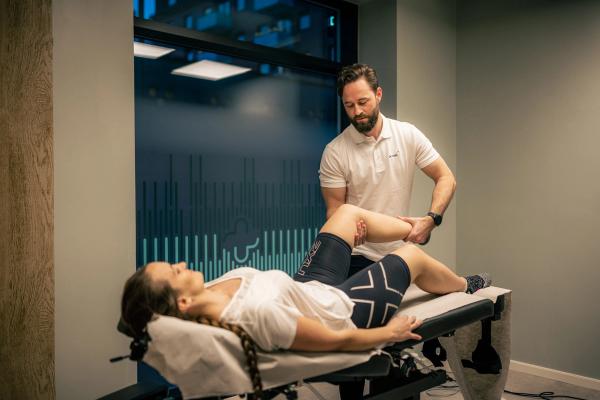Jumper's knee
Jumpers knee, also known as patellar tendonitis, is a condition that affects the tendon below the kneecap. It often develops due to repeated stress, especially in sports involving jumping and running. The pain is felt on the front of the knee and typically increases during jumping, deep squats, or stair climbing.
At Dr. Dropin, we have skilled practitioners who can assess your elbow pain and help you receive the appropriate treatment.
See availability
What are you looking for?
Symptoms of jumper's knee
If you have jumper's knee, you may experience one or more of the following symptoms:
- Pain under the kneecap, especially during activities like jumping or running
- Tenderness to touch or pressure under the kneecap
- Stiffness and pain after periods of inactivity
Jumper's knee is a condition that often develops gradually, and symptoms can vary in severity. It is important to seek professional help for an accurate diagnosis and treatment if you experience these symptoms.

Treatment
The treatment of jumper's knee often involves various approaches to achieve different treatment goals. Here are some common focus areas and treatment methods:
- Pain Relief: Through manual techniques such as massage and trigger point therapy, knee pain can be reduced.
- Increased Flexibility: Specific stretching exercises and techniques can help improve the mobility of the knee, hip, and ankle.Strength Training: Gradual introduction of strength exercises stimulates tendon growth and increased capacity.
- Shockwave Therapy: Contributes to better healing ability in the tendon and faster results.
- Biomechanical Evaluation: Analysis of jumping and running techniques, and potential adjustments to footwear or insoles, to reduce the strain on the patellar tendon.
- Functional Rehabilitation: Gradual resumption of jumping and other daily activities, with a focus on restoring optimal function in the knee.
The treatment for jumper's knee should be tailored to individual needs and may vary from person to person. A thorough evaluation and close collaboration with an experienced physiotherapist or chiropractor are crucial for developing an effective treatment plan.
See availabilityWhen should you book an appointment?
If you recognize the symptoms above and are experiencing any of the following issues, we recommend seeking professional guidance:
- Pain or reduced mobility that has persisted for more than a week without improvement.
- Severe symptoms that you need assistance in reducing quickly.
- Symptoms that cause you concern or that you believe may be due to more serious conditions.
Remember that early assistance from a therapist can reduce the duration of your issues and contribute to achieving the best possible outcome. You should never worry that your problems are "too small" - we take all types of issues seriously.
See availability
Find clinic and therapist

Find therapist
Find a therapist that suits you and your needs by filtering on one or more criteria.

Telephone
Authorized healthcare personnel assist you over the phone. We answer the phone within 60 seconds. Free of charge.
Use your health insurance
We cooperate with all the major insurance companies, so that you can use your health insurance with us if you have knee pain or other problems.
Read more about how to use your health insurance here
What can you do by yourself?
Although treatment for jumper's knee often involves professional care, there are measures you can take to alleviate symptoms and improve the condition:
- Follow recommended exercises: Regularly perform at-home exercises provided by your therapist.
- Stay active: Don't completely stop jogging or doing other activities. Short jogs without pain are usually acceptable.
- Pain relief: Reduce pain with an ice pack, heating pad, warm shower, or gentle movements.
- Medications: Use over-the-counter pain relievers as recommended by healthcare professionals.
- Adapt activities: Avoid prolonged activities that worsen knee pain (more than 12 hours).
If you haven't had the condition examined or have deviated from the treatment plan, it is recommended to consult healthcare professionals for further guidance.
See availabilityFrequently asked questions about jumper's knee
How long does it take to recover from jumper's knee?
Recovery time varies, but it often takes several weeks to months with proper treatment and rehabilitation.
How long does it take to recover from jumper's knee?
Recovery time varies, but it often takes several weeks to months with proper treatment and rehabilitation.
How is jumper's knee diagnosed?
Diagnosis is typically made through a combination of clinical assessment, patient symptoms, and sometimes medical imaging such as ultrasound or MRI to confirm the condition.
How is jumper's knee diagnosed?
Diagnosis is typically made through a combination of clinical assessment, patient symptoms, and sometimes medical imaging such as ultrasound or MRI to confirm the condition.
Is Jumpers Knee the same as Runner's Knee?
No, Jumper's Knee affects the patellar tendon, while Runner's Knee is typically used to refer to pain in the tendon on the outside of the knee (iliotibial band).
Is Jumpers Knee the same as Runner's Knee?
No, Jumper's Knee affects the patellar tendon, while Runner's Knee is typically used to refer to pain in the tendon on the outside of the knee (iliotibial band).
Can I continue exercising with jumper's knee
It is usually okay to continue exercising with jumper's knee. However, it is important to adjust the activity level so that you do not exacerbate the pain.
Can I continue exercising with jumper's knee
It is usually okay to continue exercising with jumper's knee. However, it is important to adjust the activity level so that you do not exacerbate the pain.